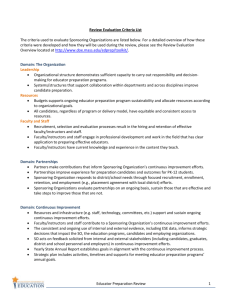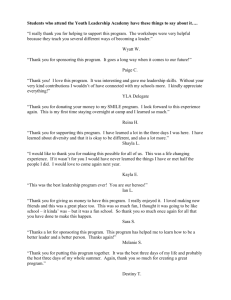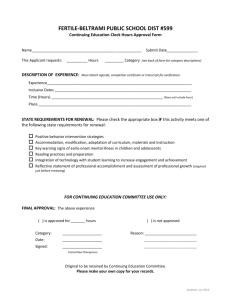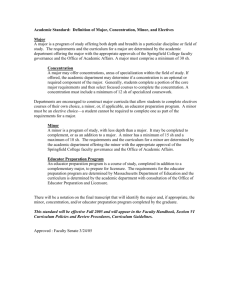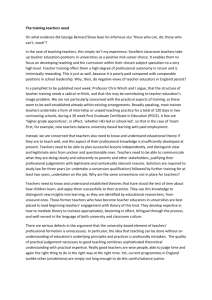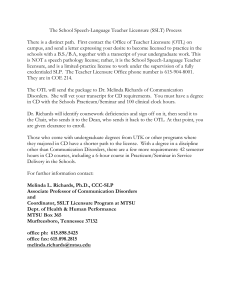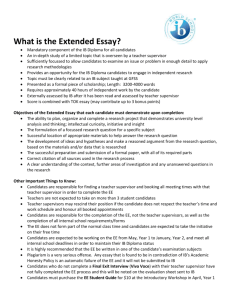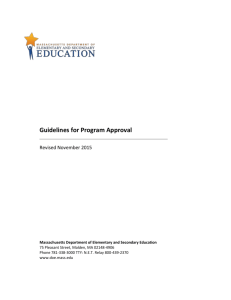Eval Tool Criteria List - Massachusetts Department of Education
advertisement
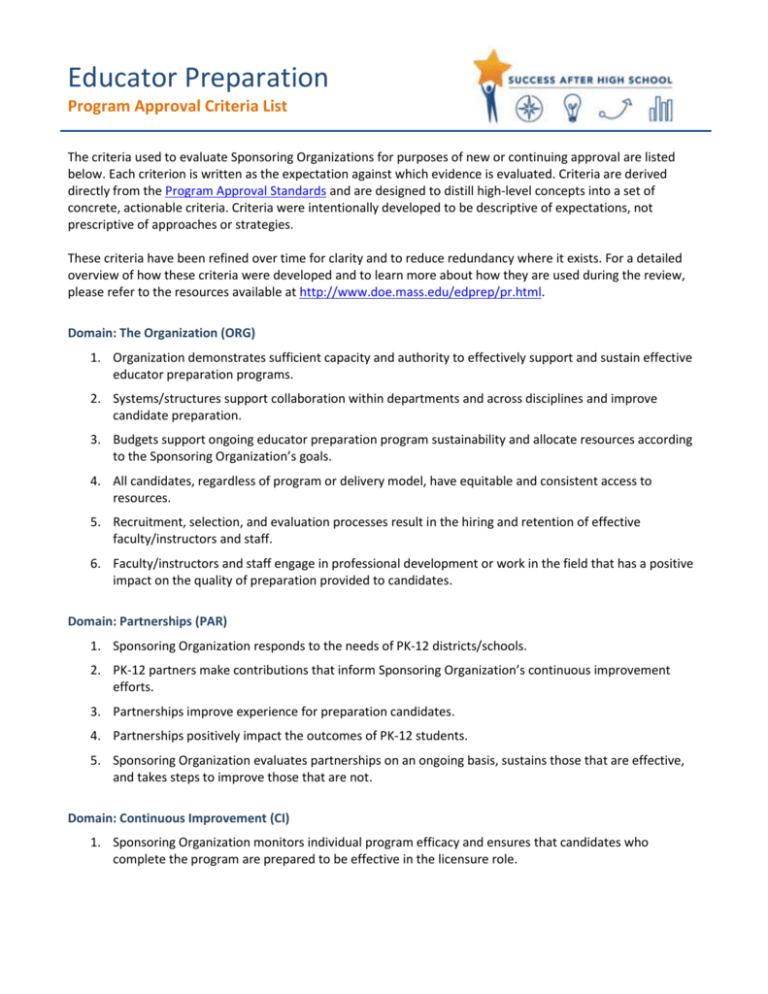
Educator Preparation Program Approval Criteria List The criteria used to evaluate Sponsoring Organizations for purposes of new or continuing approval are listed below. Each criterion is written as the expectation against which evidence is evaluated. Criteria are derived directly from the Program Approval Standards and are designed to distill high-level concepts into a set of concrete, actionable criteria. Criteria were intentionally developed to be descriptive of expectations, not prescriptive of approaches or strategies. These criteria have been refined over time for clarity and to reduce redundancy where it exists. For a detailed overview of how these criteria were developed and to learn more about how they are used during the review, please refer to the resources available at http://www.doe.mass.edu/edprep/pr.html. Domain: The Organization (ORG) 1. Organization demonstrates sufficient capacity and authority to effectively support and sustain effective educator preparation programs. 2. Systems/structures support collaboration within departments and across disciplines and improve candidate preparation. 3. Budgets support ongoing educator preparation program sustainability and allocate resources according to the Sponsoring Organization’s goals. 4. All candidates, regardless of program or delivery model, have equitable and consistent access to resources. 5. Recruitment, selection, and evaluation processes result in the hiring and retention of effective faculty/instructors and staff. 6. Faculty/instructors and staff engage in professional development or work in the field that has a positive impact on the quality of preparation provided to candidates. Domain: Partnerships (PAR) 1. Sponsoring Organization responds to the needs of PK-12 districts/schools. 2. PK-12 partners make contributions that inform Sponsoring Organization’s continuous improvement efforts. 3. Partnerships improve experience for preparation candidates. 4. Partnerships positively impact the outcomes of PK-12 students. 5. Sponsoring Organization evaluates partnerships on an ongoing basis, sustains those that are effective, and takes steps to improve those that are not. Domain: Continuous Improvement (CI) 1. Sponsoring Organization monitors individual program efficacy and ensures that candidates who complete the program are prepared to be effective in the licensure role. Program Approval Criteria List 2. The consistent and ongoing use of internal and external evidence, including ESE data, informs strategic decisions that impact the Sponsoring Organization, education programs, candidates, and employing schools/districts. 3. Sponsoring Organization acts on feedback solicited from internal and external stakeholders (including candidates, graduates, district and school personnel, and employers) in continuous improvement efforts. 4. Goals articulated in the State Annual Report yield improvements to the Sponsoring Organization’s educator preparation programs. Domain: The Candidate (CAN) 1. Systems to recruit and admit candidates result in the increased racial and ethnic diversity of completers in the workforce. 2. Admission criteria and processes are rigorous such that those admitted demonstrate success in the program and during employment in the licensure role. 3. Candidates receive effective advising throughout the program (including, but not limited to, being knowledgeable about licensure requirements and career development and placement services that contribute to employment upon completion). 4. Candidates at risk of not meeting standards are identified throughout the program (in pre-practicum, during coursework, and while in practicum) and receive necessary supports and guidance to improve or exit the program. 5. Waiver policy ensures that academic and professional standards of the licensure role are met. Domain: Field-Based Experiences (FBE) 1. Practicum hours meet regulatory requirements as per 603 CMR 7.04 (4) 2. District partners are involved in the design, implementation, and assessment of field-based experiences. 3. Field-based experiences are fully embedded in program coursework such that connections between theory and practice are explicit. 4. Responsibilities in pre-practicum and practicum experiences build to candidate readiness for full responsibility in licensure role. 5. Sponsoring Organization secures and/or verifies placement(s) that meet regulatory requirements and the SO’s expectations for a high-quality placement for all candidates. 6. Candidates participate in field-based experiences that cover the full academic year. 7. Field-based experiences are in settings with diverse learners (e.g., students from diverse ethnic, racial, gender, socioeconomic, and exceptional groups). 8. Supervising Practitioner qualifications meet regulatory requirements set forth in 603 CMR 7.02 and in Guidelines for Program Approval. 9. Supervising Practitioners and Program Supervisors receive training, support and development from the SO that impacts candidate effectiveness. 10. Candidates receive high-quality, targeted feedback during field-based experiences that improves their practice. Educator Preparation Review 2 Program Approval Criteria List 11. Sponsoring Organization ensures that Program Supervisors and Supervising Practitioners are measurably contributing to and effectively evaluating the readiness of candidates. 12. Candidate readiness for the licensure role is measured using a performance assessment (e.g. Candidate Assessment of Performance) that is implemented consistently across/within programs and rigorously such that only candidates who are ready to make a positive impact for PK-12 students in the licensure role complete the program. Domain: Instruction (INS) Sponsoring Organizations must monitor individual program efficacy (see CI Domain). For purposes of review, ESE will evaluate the quality of instruction with aggregated evidence for the following programs types: Initial Teacher – Baccalaureate, Initial Teacher – Post-Baccalaureate, Initial Teacher Specialist (e.g., Reading Specialist), Professional, Professional Support Personnel, and Administrative Leadership. Outcome Criteria: 1. Completers have the content knowledge (SMK) to be effective in the licensure role. For Professional licensure programs: Completers have deeper content knowledge that makes them more effective in the licensure role. 2. Completers have the pedagogical skills (PST/PSAL) to be effective in the licensure role. For Professional licensure programs: Completers have increased pedagogical skill that makes them more effective in the licensure role. 3. Completers have a positive impact on outcomes for PK-12 students. For Professional licensure programs: Completers have an increasingly positive impact on outcomes for PK-12 students. Supporting (Input) Criteria: a) Program(s) of Study is sequenced to support the increased depth of skills and knowledge acquired and applied over time. b) Program design results in a coherent program of study such that connections among and between courses are evident. c) Content is differentiated by subject area and level of licensure. d) Content delivery is calibrated for consistency within programs (e.g. different instructors of same course, in satellites, online, etc.). e) Faculty/instructors model effective pedagogical and content practices of discipline (including strategies to meet the needs of diverse learners). f) Faculty/instructors use formative and summative assessment data to target areas of candidate need. g) Candidates receive targeted feedback from faculty/instructors in coursework that improves their practice. Educator Preparation Review 3
